Formula One at Watkins Glen: 20 Years of the United States Grand Prix
Author: Michael Argetsinger
Foreword: Mario Andretti
Format: Hardcover, 9” x 11”, 160 pages
Photos: 91 black-and-white and 150 color photographs
ISBN: 978-1-935007-14-2
Price: $49.95
Review by Pete Vack
Michael Argetsinger has already made quite a reputation as a racing historian with his award-winning books “Mark Donohue: Technical Excellence at Speed” and “Walt Hansgen: His Life and the History of Post-War American Road Racing”, both works of incredible original research.
His latest, “Formula One at Watkins Glen: 20 Years of the United States Grand Prix”, is a completely different animal. Written and completed in time for the 50th Anniversary of Formula One racing at the Glen, Argetsinger writes from a unique perspective with the full cooperation of the IMRRC as the Glen celebrates the fifty year anniversary of the first FIA Grand Prix race at Watkins Glen, And a good thing too, as the U.S. is still struggling to get an F1 race on the calendar we often forget that for 20 years, the picturesque track at the Glen was home to the U.S. Grand Prix and witnessed the evolution of Formula One from dirt floor garages to a multi-billion dollar a year industry.
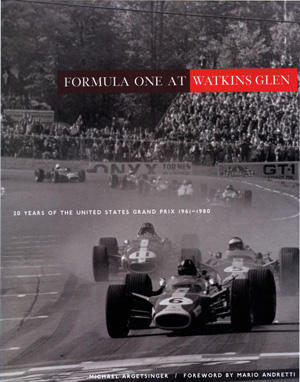 It should be mentioned up front that all—100%–of the monies from this book will go directly to one of our favorite non-profit organizations, the International Motor Racing Research Center in Watkins Glen. David Bull, the publisher, produced a top quality hard cover book for cost; the photographers whose photos constitute the book generously permitted the use of their images without compensation. Needless to say, Argetsinger himself, a longtime supporter of the IMRRC, received no compensation for his efforts. Support the IMRRC and get an excellent book for only $50; can’t go wrong there. It can be purchased via the IMRRC click here to order , or by phone at 607.535.9044.
It should be mentioned up front that all—100%–of the monies from this book will go directly to one of our favorite non-profit organizations, the International Motor Racing Research Center in Watkins Glen. David Bull, the publisher, produced a top quality hard cover book for cost; the photographers whose photos constitute the book generously permitted the use of their images without compensation. Needless to say, Argetsinger himself, a longtime supporter of the IMRRC, received no compensation for his efforts. Support the IMRRC and get an excellent book for only $50; can’t go wrong there. It can be purchased via the IMRRC click here to order , or by phone at 607.535.9044.
For this book, Argetsinger went through over 47,000 (three zeros) photographs to come up with a critical selection of color and black and white images which are published in this book. The photos and chapters cover both the years of the Formula Libre races in 1958-60 then by year and chapter, Argetsinger picks out the best shots from the years of the FIA U.S. Grand Prix. If you’re looking for straight results and stats, they aren’t here. As Argetsinger states in the Acknowledgements, “I did not approach this book as the definitive history of the Formula One experience at Watkins Glen. It is primarily a photographic record of those twenty years, from 1961 to 1980, of the races, the cars, and the people…”
All true, but Argetsinger guides us through the years as few others can. Argetsinger’s father Cameron was the original founder of the Watkins Glen races in 1948, and the entire family was involved in the organization of the races. As a young man Michael was engaged in everything from timing to promotion; after a stint in the Army Michael spent time in Europe, working and helping the Cooper F1 team on race weekends and was his father’s emissary to the Formula One team principles for many years. Michael Argetsinger explains how the Glen became home to the U.S. Grand Prix. Sebring’s Alec Ulmann had a three year contract to hold the U.S. Grand Prix but the events were not financially viable. Cameron Argetsinger had already established a series of Formula Libre events which attracted a number of Formula One cars and drivers and suddenly the CSI (racing branch of the FIA) asked Cameron Argetsinger if he could organize the 1961 event. With only six weeks’ notice Argetsinger got the job done and on October 8th, 1961, the first of 20 Grand Prix races was successfully held at the Glen.
A little known fact was that in 1970, Cameron Argetsinger’s bid to purchase the track was rejected and the leadership changed hands. A bond issue updated the track but bond’s debt service spelled the end of the Grand Prix Corporation and eventually “resulted in the loss to Watkins Glen of the United States Grand Prix after 1980.” Things haven’t gone well for the U.S. Grand Prix ever since.
Throughout the book, Argetsinger’s captions and comments add fresh insight to a colorful selection of photos not normally published. Captions are in depth and illuminating, giving great value to the selected photos. The text is brief but accurate and peppered throughout the chapters are quotes from drivers relevant to the particular event, starting with Innes Ireland, including Graham Hill, Mario Andretti (who also wrote the Forward), Jacky Ickx and Jody Scheckter. All of this adds up to a very interesting read.
In the Epilogue, Argetsinger tells us why there are now NASCAR events at the Glen. After bankruptcy in the early 1980s, the track was purchased by local industry Corning Glass, whose officers were NASCAR fans. The Winston Cup filled the bill and the track is once again in healthy financial condition. Did this bother the late Cameron Argetsinger? Not in the least, he said. “The important point is that sixty years after we started all this, racing remains an economic engine, not only for Watkins Glen, but for the entire upstate New York region.”
Photos from the book:
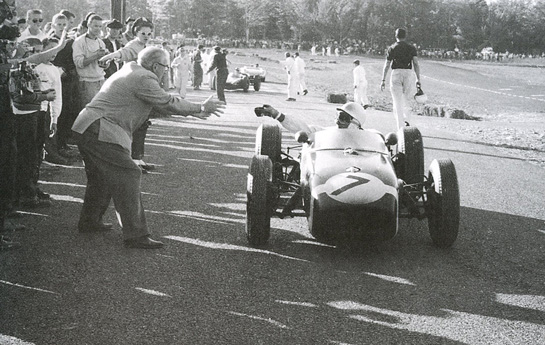
1960. Argetsinger organized another Formula Libre event in which Stirling Moss won after a battle with a Cooper driven by Jack Brabham. Here Moss hands his father Alfred a cup of tea which he had taken on in the pits before his cool down lap. Very British.
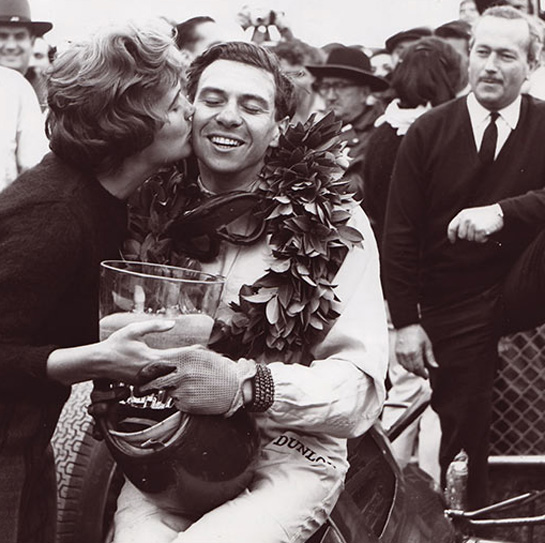
October 7th 1962. Jim Clark's victory resulted in a well earned kiss from Pat Gannon. In the background, Colin Chapman is obviously is just as pleased.
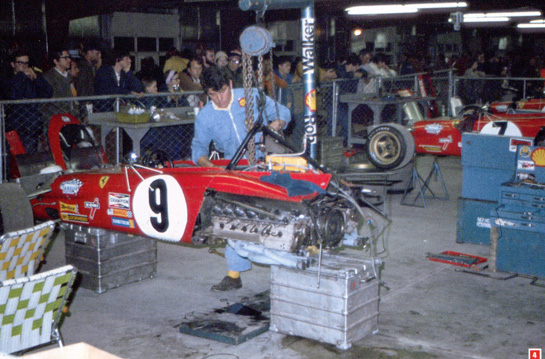
1972. Inside the Kendall Garage the Ferrari 312s of Andretti and Jackie Ickx gets attention. Apparently there were not enough jack stands to go around and Andretti’s car sits on cargo boxes. How times have changed. But as Argetsinger points out, Ferrari had finally moved to the Kendall building in 1970 after garaging in Downtown Waktins Glen in the 1960s to keep out prying eyes.
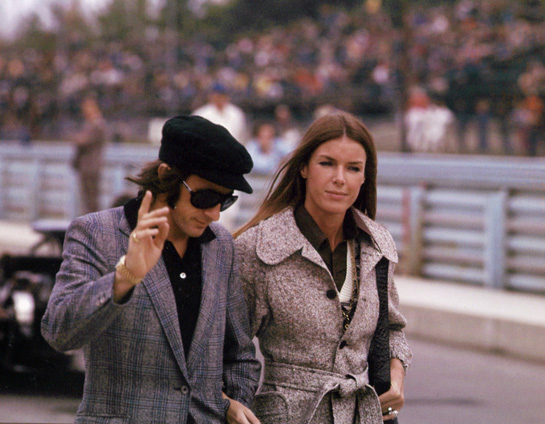
1973. Jackie Stewart wins his third world championship and retires after the U.S. Grand Prix where his friend and teammate Francois Cevert perished in a horrific accident. Jackie and Helen seem to be saying goodbye to Formula One.
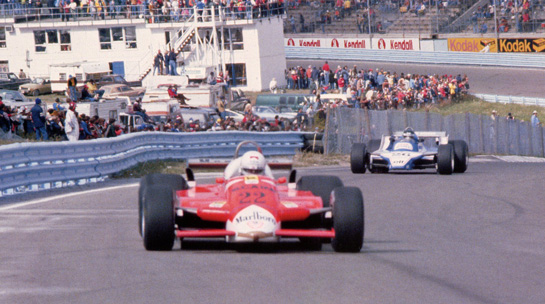
1980. And do we remember that Bruno Giacomelli very nearly won the U.S.Grand Prix in an Alfa Romeo, leading from the start until lap 32, when his electrics failed? World Champion Alan Jones won the event in a Williams FW07-Ford. Pictured here is the number 22 car of Andrea De Cesaris.
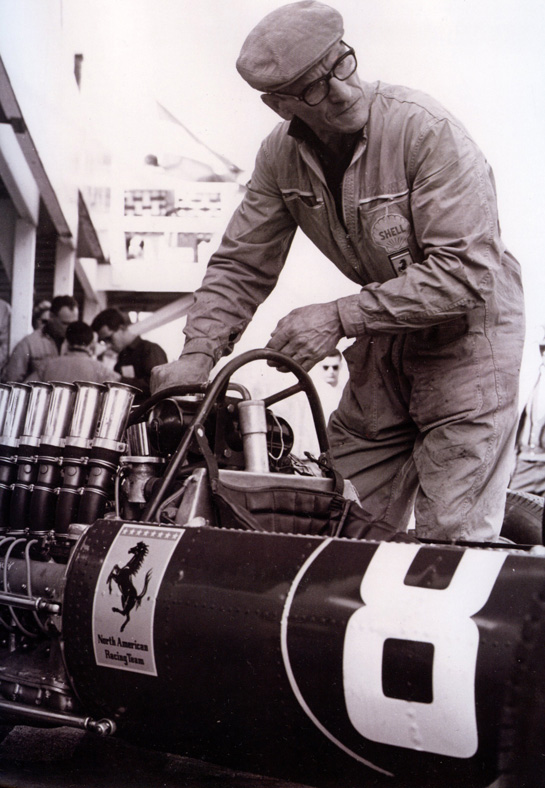
Pete – I reckon that Bandini’s V8 (top of article) looks more like the first 12 cylinder that Ferrari used in ’64 and ’65, which they alternated with the old V6 and the new V8 that John Surtees usually favoured. Makes the modern setups seem a bit tame to my way of thinking!
It seems the second car was a Ligier, don’t you know ?
Your mention of Bandini and Surtees above reminded me of one of my times at the Glenn. I had flown in to a local airport with a friend who worked at the GM Tech Center. We were to be guests of the local Chevy dealer for the race. Waiting at the Chevy Service Dept we were shocked to see the Ferraris come in on the car hauler painted in blue and white. Apparently Enzo was mad at the Italian govt. and raced in the U.S. under the North American Racing colors that year. That evening, Surtees still in his coveralls, was working with the mechanics to get the cars set up for next days race. Later, Bandini with a couple of chicks on his arms arrived, sort of waved and left. Always had greater respect for Surtees after that. Due to the gusty wind conditions the engineers were worried on how to set up the gearing for the cars on race day. Being pilots we called flight service to get the weather for race time and became the unofficial Ferrari weather service. Next day at the track pits where all the rest of the cars were, I got to meet all my hero drivers. Also
C. Chapman, Gurney, Clark, Moss. etc., etc. Remember having a great conversation with a beautiful blond which turned out to be S. Moss wife. I was crushed. Was that the year when Clark was left on the grid because his car would not start? l remember him having a flying race all by himself for several laps.
I saw two races at the Glann and time dims my memory. Anyway, it was
‘Hog Heaven’ for a car nut in those days.
Yes, Nick is right, this is a 12 cyl 1512 F1 (also called 512 F1) in the front picture.
Funny, in pic #4, is the hoist with the Rob Walker marks used by the Ferrari mechanic to lift the 312 (B2 ?) #9…!
I shot for AP at Watkins Glen from the mid-’70s to the early ’80s. So, yes, some of us do remember 1980. Giacomelli led from pole, from Piquet, Reutemann, de Angelis, and Jones, who was leading the championship by 8 points over Piquet (back when 1st was 9 points). According to the incident report, 53 mins. in, Station 17 reported Giacomelli’s car #23 “off course, driver out, electrical cable came off”.
So that’s a nice photo–it’s Turn 3, a.k.a. the Esses–but I’m afraid it’s not Giacomelli. That’s Andrea De Cesaris in #22. He qualified mid-pack, tenth of twenty-four, but he finished dead last, dropping out after only 2 laps. Since he dropped out so early, any race photo would have more cars in it. I’ll wager it was shot in Saturday practice.
Thanks for taking me back, Pete.
re: the Jackie & Helen Stewart shot, Stewart didn’t retire after the 1973 USGP. It was to be his 100th, and last race. But he actually retired before the race; he withdrew after Cevert’s death in practice on Saturday.
And the guys are right about the 1964 Bandini car being a 512. Too bad it’s not a color shot, or you’d see that bodywork is blue. Ferrari was annoyed with the Italian sanctioning body (for not pushing the FIA hard enough to homologate the 250LM, IIRC), so for the Mexican and US GPs he painted the cars in US racing colors of white and blue, and entered them under Chinetti’s NART.
Thanks for catching these errors, I’ve corrected the captions. Michael did indeed caption the Bandini Ferrari correctly as a flat 12 in the book. Twas I who got the model wrong.
[Ed]
The 64 1512 reminds me that a 158 chassis showed up at practice at the Glen with the blue body stripe AND two flanking thinner red stripes. Two 158s were at the practice along with the 156-64 car. Does anyone know about the #7 158 with the red and blue stripes? There is a picture on page 112 of Mark Whitlock’s book, 1 1/2-liter Grand Prix Racing 1961-65.